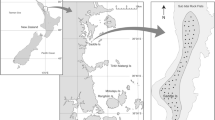Abstract
The size and spatial distribution of home ranges in two sympatric field mouse species,Apodemus speciosus andApodemus argenteus, were revealed by the capture-recapture method in a temperate deciduous forest from June 1987 to June 1990. InA. speciosus, the home ranges of males were significantly larger tha those of females, and overlapped with those of other males and females during the breeding season. InA. argenteus, the home range of each male overlapped only that of a single female throughout the year. These results suggested thatA. speciosus was promiscuous or polygynous andA. argenteus was monogamous.
Similar content being viewed by others

References
Abe M. T. (1989) The use of artificial nesting boxes by some mammal species.Mammal. Sci. 29: 37–48 (in Japanese with English summary).
Abe H., Shida T. &Saitoh T. (1989) Effects of reduced vertical space and arboreal food supply on densities of three forest rodents.J. Mammal. Soc. Jap. 14:43–52.
Batzli G. O., Getz L. L. &Hurley S. (1977) Suppression of growth and reproduction in microtine rodents by social factors.J. Mammal. 58: 583–91.
Clutton-Brock T. H. (1989) Mammalian mating systems.Proc. R. Soc. Lond. Series B236: 339–72.
Clutton-Brock T. H. &Harvey P. H. (1978) Mammals, resources and reproductive strategies.Nature 273: 191–5.
Doi T. &Iwamoto T. (1982) Local distribution of two species ofApodemus in Kyushu.Res. Popul. Ecol. 24: 110–22.
Doi T., Nagayama T. &Miyaji M (1982) An experimental study on climbing ability ofApodemus argenteus andApodemus speciosus.J. Mammal. Soc. Jap. 9: 42–7.
Emlen S. T. &Oring L. W. (1977) Ecology, sexual selection, and the evolution of mating systems.Science 197: 215–23.
Fitzgerald R. W. &Madison D. M. (1983) Social organization of a free-ranging population of pine voles,Microtus pinetorum.Behav. Ecol. Sociobiol. 13: 183–7.
Getz L. L., Carter C. S. &Gavish L. (1981) The mating system of the prairie vole,Microtus ochrogaster: Field and laboratory evidence for pairbonding.Behav. Ecol. Sociobiol 8: 189–94.
Getz L. L. &Hofmann J. E. (1986) Social organization in free-living prairie voles,Microtus ochrogaster.Behav. Ecol. Sociobiol. 18: 275–82.
Kitahara E., Ohga, R. &Hashimoto, S. (1983) Notes on the distribution of small mammals and reproductive activities of rodents in Oku-Nikko.Mem. Tochigi Pref. Mus. 1: 19–38 (in Japanese with English summary).
Kleiman D. G. (1977) Monogamy in mammals.Quart. Rev. Biol. 52: 39–69.
Lidicker, W. Z. Jr (1980) The social biology of the California vole.Biologist 62: 46–55.
Maynard-Smith J. (1977) Parental investment: A prospective analysis.Anim. Behav. 25: 1–9.
Miyao T., Morozumi T., Morozumi M., Hanamura H., Sato N., Akahane H. &Sakai A. (1963) Small mammals on Mt Yatsugatake. 1. Small mammals in the subalpine forest zone on Mt Yatsugatake.Zool. Mag. 72: 133–138 (in Japanese with English summary).
Murakami O. (1974) Growth and development of the Japanese wood mouse (Apodemus speciosus). I. The breeding season in the field.Jpn. J. Ecol. 24: 194–206 (in Japanese with English summary).
Nishikata S. (1982) Ecological studies on the population ofApodemus argenteus on Mt Kiyosumi, Chiba Prefecture. (II) Social structure and its role.J. Jpn. For. Soc. 64: 249–56.
Orians G. H. (1969) On the evolution of mating systems in birds and mammals.Am. Nat. 103: 589–603.
Ostfeld R. S. (1986) Territoriality and mating system of California voles.J. Anim. Ecol. 55: 691–706.
Randolph J. C. (1973) Ecological energetics of a homeothermic predator, the short-tailed shrew.Ecology 54: 1166–87.
Randolph S. E. (1977) Changing spatial relationships in a population ofApodemus sylvaticus with the onset of breeding.J. Anim. Ecol. 46: 653–76.
Setoguchi, M. (1981) Utilization of holes and home ranges in the Japanese long-tailed mice (Apodemus argenteus).Jpn. J. Ecol. 31: 385–94 (in Japanese with English summary).
Trivers R. L. (1972) Parental investment and sexual selection. In:Sexual Selection and the Descent of Man (ed. B. Campbell) pp. 136–79. Aldine, Chicago.
Verner J. &Willson M. F. (1966) The influence of habitats on mating systems of North American passerine birds.Ecology 47: 143–7.
Wynne-Edwards, K. E. (1987) Evidence for obligate monogamy in the Djungarian hamster,Phodopus campbelli: Pup survival under different parenting conditions.Behav. Ecol. Sociobiol. 20: 427–37.
Author information
Authors and Affiliations
About this article
Cite this article
Oka, T. Home range and mating system of two sympatric field mouse species,Apodemus speciosus andApodemus argenteus . Ecol. Res. 7, 163–169 (1992). https://doi.org/10.1007/BF02348495
Accepted:
Issue Date:
DOI: https://doi.org/10.1007/BF02348495



